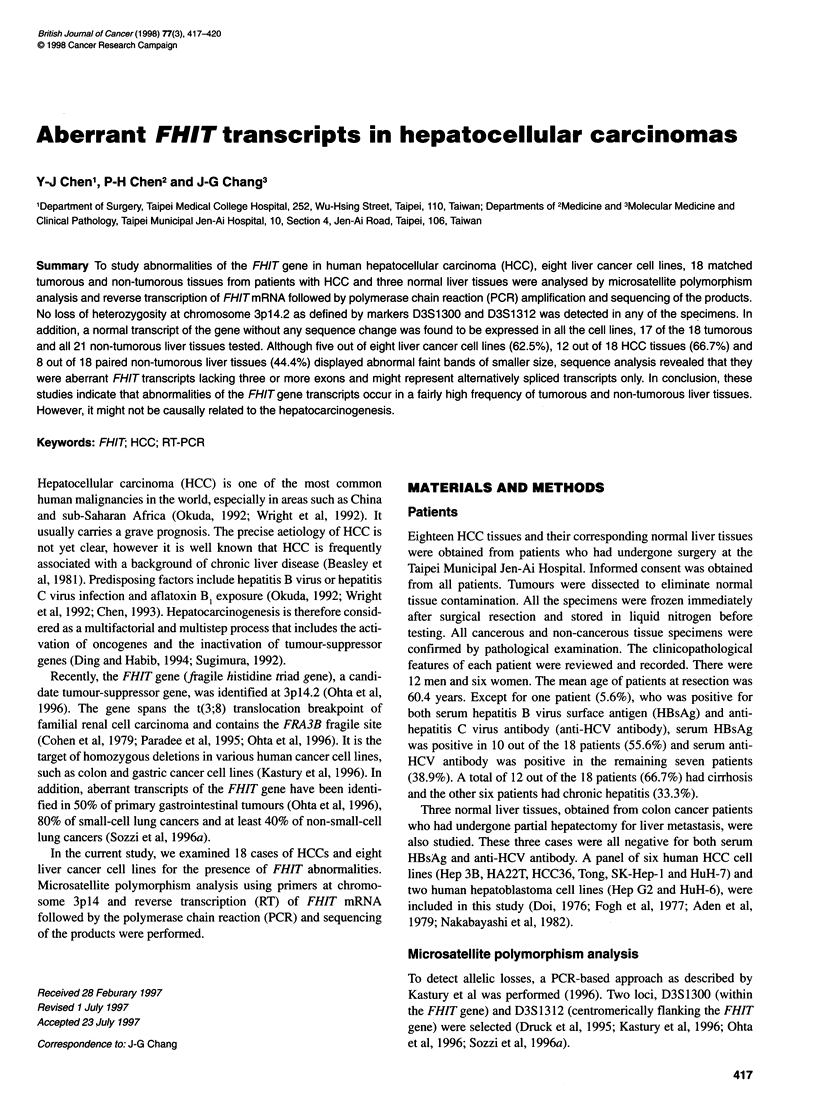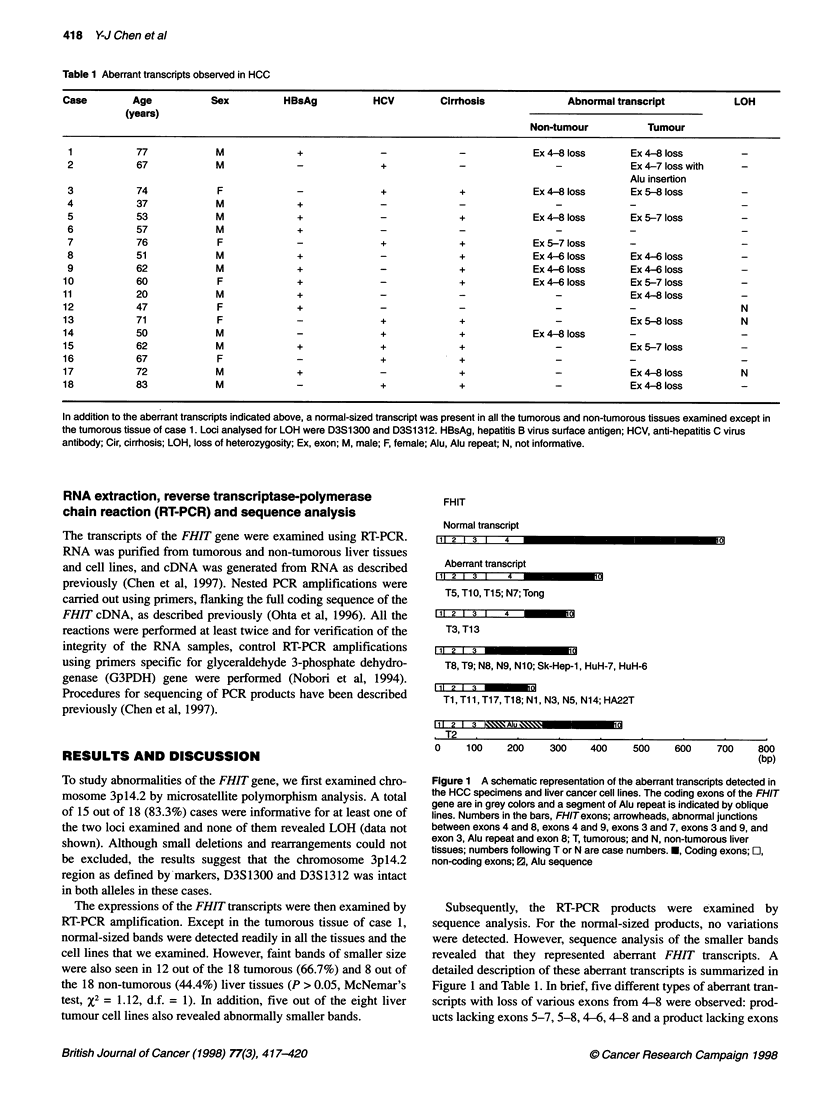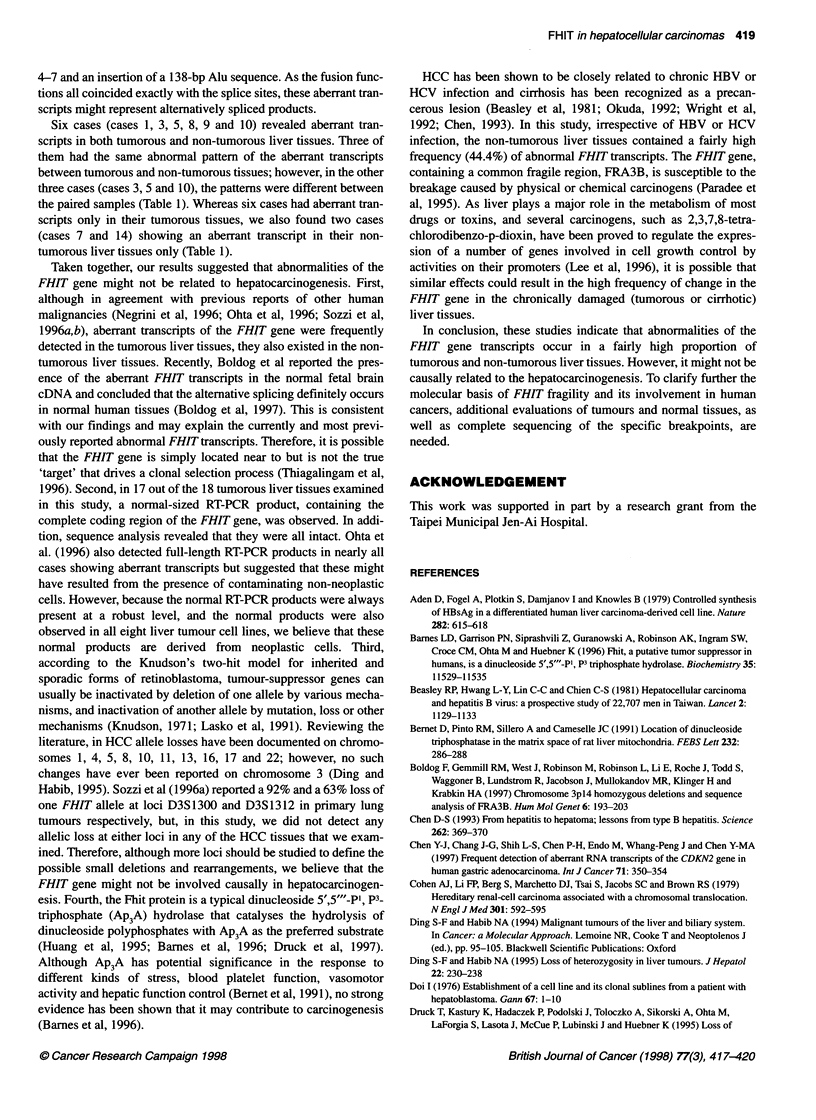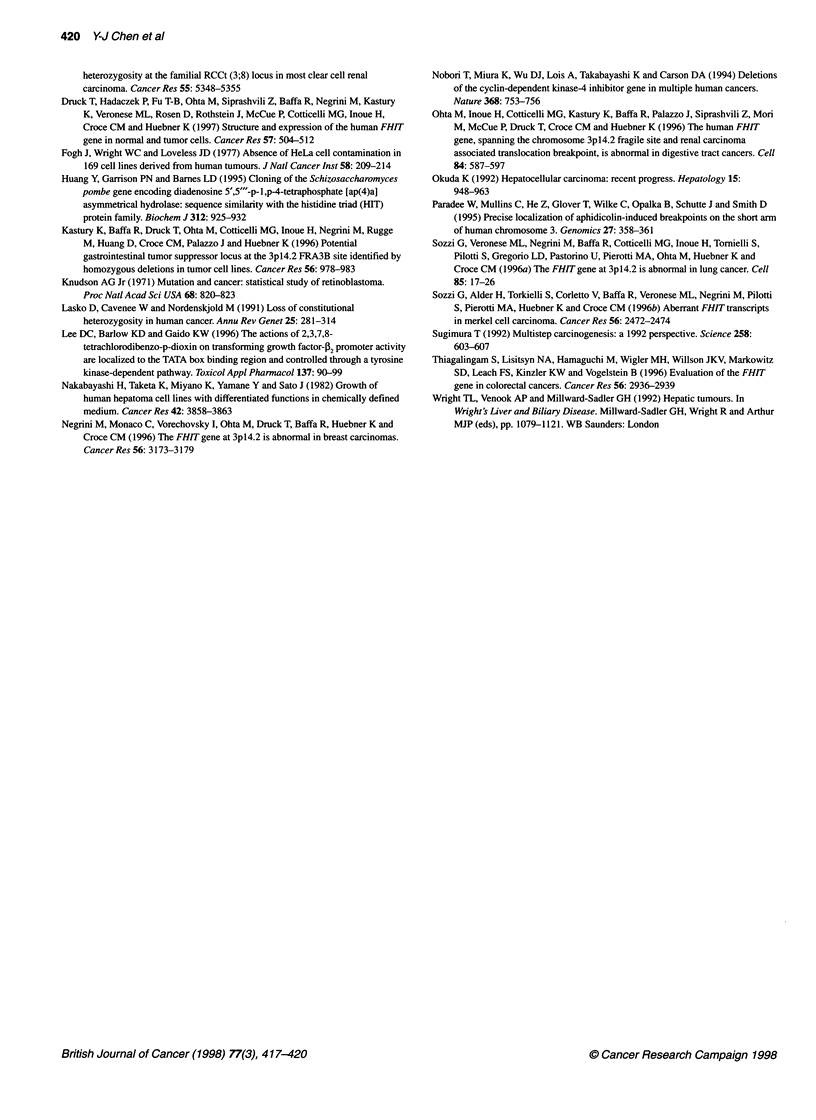Abstract
To study abnormalities of the FHIT gene in human hepatocellular carcinoma (HCC), eight liver cancer cell lines, 18 matched tumorous and non-tumorous tissues from patients with HCC and three normal liver tissues were analysed by microsatellite polymorphism analysis and reverse transcription of FHIT mRNA followed by polymerase chain reaction (PCR) amplification and sequencing of the products. No loss of heterozygosity at chromosome 3p14.2 as defined by markers D3S1300 and D3S1312 was detected in any of the specimens. In addition, a normal transcript of the gene without any sequence change was found to be expressed in all the cell lines, 17 of the 18 tumorous and all 21 non-tumorous liver tissues tested. Although five out of eight liver cancer cell lines (62.5%), 12 out of 18 HCC tissues (66.7%) and 8 out of 18 paired non-tumorous liver tissues (44.4%) displayed abnormal faint bands of smaller size, sequence analysis revealed that they were aberrant FHIT transcripts lacking three or more exons and might represent alternatively spliced transcripts only. In conclusion, these studies indicate that abnormalities of the FHIT gene transcripts occur in a fairly high frequency of tumorous and non-tumorous liver tissues. However, it might not be causally related to the hepatocarcinogenesis.
Full text
PDF



Selected References
These references are in PubMed. This may not be the complete list of references from this article.
- Aden D. P., Fogel A., Plotkin S., Damjanov I., Knowles B. B. Controlled synthesis of HBsAg in a differentiated human liver carcinoma-derived cell line. Nature. 1979 Dec 6;282(5739):615–616. doi: 10.1038/282615a0. [DOI] [PubMed] [Google Scholar]
- Barnes L. D., Garrison P. N., Siprashvili Z., Guranowski A., Robinson A. K., Ingram S. W., Croce C. M., Ohta M., Huebner K. Fhit, a putative tumor suppressor in humans, is a dinucleoside 5',5"'-P1,P3-triphosphate hydrolase. Biochemistry. 1996 Sep 10;35(36):11529–11535. doi: 10.1021/bi961415t. [DOI] [PubMed] [Google Scholar]
- Beasley R. P., Hwang L. Y., Lin C. C., Chien C. S. Hepatocellular carcinoma and hepatitis B virus. A prospective study of 22 707 men in Taiwan. Lancet. 1981 Nov 21;2(8256):1129–1133. doi: 10.1016/s0140-6736(81)90585-7. [DOI] [PubMed] [Google Scholar]
- Bernet D., Pinto R. M., Sillero A., Cameselle J. C. Location of dinucleoside triphosphatase in the matrix space of rat liver mitochondria. FEBS Lett. 1991 Jun 3;283(2):286–288. doi: 10.1016/0014-5793(91)80609-7. [DOI] [PubMed] [Google Scholar]
- Boldog F., Gemmill R. M., West J., Robinson M., Robinson L., Li E., Roche J., Todd S., Waggoner B., Lundstrom R. Chromosome 3p14 homozygous deletions and sequence analysis of FRA3B. Hum Mol Genet. 1997 Feb;6(2):193–203. doi: 10.1093/hmg/6.2.193. [DOI] [PubMed] [Google Scholar]
- Chen D. S. From hepatitis to hepatoma: lessons from type B viral hepatitis. Science. 1993 Oct 15;262(5132):369–370. doi: 10.1126/science.8211155. [DOI] [PubMed] [Google Scholar]
- Chen Y. J., Chang J. G., Shih L. S., Chen P. H., Endo M., Whang-Peng J., Chen Y. M. Frequent detection of aberrant RNA transcripts of the CDKN2 gene in human gastric adenocarcinoma. Int J Cancer. 1997 May 2;71(3):350–354. doi: 10.1002/(sici)1097-0215(19970502)71:3<350::aid-ijc7>3.0.co;2-x. [DOI] [PubMed] [Google Scholar]
- Cohen A. J., Li F. P., Berg S., Marchetto D. J., Tsai S., Jacobs S. C., Brown R. S. Hereditary renal-cell carcinoma associated with a chromosomal translocation. N Engl J Med. 1979 Sep 13;301(11):592–595. doi: 10.1056/NEJM197909133011107. [DOI] [PubMed] [Google Scholar]
- Ding S. F., Habib N. A. Loss of heterozygosity in liver tumours. J Hepatol. 1995 Feb;22(2):230–238. doi: 10.1016/0168-8278(95)80434-x. [DOI] [PubMed] [Google Scholar]
- Doi I. Establishment of a cell line and its clonal sublines from a patient with hepatoblastoma. Gan. 1976 Feb;67(1):1–10. [PubMed] [Google Scholar]
- Druck T., Hadaczek P., Fu T. B., Ohta M., Siprashvili Z., Baffa R., Negrini M., Kastury K., Veronese M. L., Rosen D. Structure and expression of the human FHIT gene in normal and tumor cells. Cancer Res. 1997 Feb 1;57(3):504–512. [PubMed] [Google Scholar]
- Druck T., Kastury K., Hadaczek P., Podolski J., Toloczko A., Sikorski A., Ohta M., LaForgia S., Lasota J., McCue P. Loss of heterozygosity at the familial RCC t(3;8) locus in most clear cell renal carcinomas. Cancer Res. 1995 Nov 15;55(22):5348–5353. [PubMed] [Google Scholar]
- Fogh J., Wright W. C., Loveless J. D. Absence of HeLa cell contamination in 169 cell lines derived from human tumors. J Natl Cancer Inst. 1977 Feb;58(2):209–214. doi: 10.1093/jnci/58.2.209. [DOI] [PubMed] [Google Scholar]
- Huang Y., Garrison P. N., Barnes L. D. Cloning of the Schizosaccharomyces pombe gene encoding diadenosine 5',5"'-P1,P4-tetraphosphate (Ap4A) asymmetrical hydrolase: sequence similarity with the histidine triad (HIT) protein family. Biochem J. 1995 Dec 15;312(Pt 3):925–932. doi: 10.1042/bj3120925. [DOI] [PMC free article] [PubMed] [Google Scholar]
- Kastury K., Baffa R., Druck T., Ohta M., Cotticelli M. G., Inoue H., Negrini M., Rugge M., Huang D., Croce C. M. Potential gastrointestinal tumor suppressor locus at the 3p14.2 FRA3B site identified by homozygous deletions in tumor cell lines. Cancer Res. 1996 Mar 1;56(5):978–983. [PubMed] [Google Scholar]
- Knudson A. G., Jr Mutation and cancer: statistical study of retinoblastoma. Proc Natl Acad Sci U S A. 1971 Apr;68(4):820–823. doi: 10.1073/pnas.68.4.820. [DOI] [PMC free article] [PubMed] [Google Scholar]
- Lasko D., Cavenee W., Nordenskjöld M. Loss of constitutional heterozygosity in human cancer. Annu Rev Genet. 1991;25:281–314. doi: 10.1146/annurev.ge.25.120191.001433. [DOI] [PubMed] [Google Scholar]
- Lee D. C., Barlow K. D., Gaido K. W. The actions of 2,3,7,8-tetrachlorodibenzo-p-dioxin on transforming growth factor-beta2 promoter activity are localized to the TATA box binding region and controlled through a tyrosine kinase-dependent pathway. Toxicol Appl Pharmacol. 1996 Mar;137(1):90–99. doi: 10.1006/taap.1996.0060. [DOI] [PubMed] [Google Scholar]
- Nakabayashi H., Taketa K., Miyano K., Yamane T., Sato J. Growth of human hepatoma cells lines with differentiated functions in chemically defined medium. Cancer Res. 1982 Sep;42(9):3858–3863. [PubMed] [Google Scholar]
- Negrini M., Monaco C., Vorechovsky I., Ohta M., Druck T., Baffa R., Huebner K., Croce C. M. The FHIT gene at 3p14.2 is abnormal in breast carcinomas. Cancer Res. 1996 Jul 15;56(14):3173–3179. [PubMed] [Google Scholar]
- Nobori T., Miura K., Wu D. J., Lois A., Takabayashi K., Carson D. A. Deletions of the cyclin-dependent kinase-4 inhibitor gene in multiple human cancers. Nature. 1994 Apr 21;368(6473):753–756. doi: 10.1038/368753a0. [DOI] [PubMed] [Google Scholar]
- Ohta M., Inoue H., Cotticelli M. G., Kastury K., Baffa R., Palazzo J., Siprashvili Z., Mori M., McCue P., Druck T. The FHIT gene, spanning the chromosome 3p14.2 fragile site and renal carcinoma-associated t(3;8) breakpoint, is abnormal in digestive tract cancers. Cell. 1996 Feb 23;84(4):587–597. doi: 10.1016/s0092-8674(00)81034-x. [DOI] [PubMed] [Google Scholar]
- Okuda K. Hepatocellular carcinoma: recent progress. Hepatology. 1992 May;15(5):948–963. doi: 10.1002/hep.1840150532. [DOI] [PubMed] [Google Scholar]
- Paradee W., Mullins C., He Z., Glover T., Wilke C., Opalka B., Schutte J., Smith D. I. Precise localization of aphidicolin-induced breakpoints on the short arm of human chromosome 3. Genomics. 1995 May 20;27(2):358–361. doi: 10.1006/geno.1995.1057. [DOI] [PubMed] [Google Scholar]
- Sozzi G., Veronese M. L., Negrini M., Baffa R., Cotticelli M. G., Inoue H., Tornielli S., Pilotti S., De Gregorio L., Pastorino U. The FHIT gene 3p14.2 is abnormal in lung cancer. Cell. 1996 Apr 5;85(1):17–26. doi: 10.1016/s0092-8674(00)81078-8. [DOI] [PubMed] [Google Scholar]
- Sugimura T. Multistep carcinogenesis: a 1992 perspective. Science. 1992 Oct 23;258(5082):603–607. doi: 10.1126/science.1411570. [DOI] [PubMed] [Google Scholar]
- Thiagalingam S., Lisitsyn N. A., Hamaguchi M., Wigler M. H., Willson J. K., Markowitz S. D., Leach F. S., Kinzler K. W., Vogelstein B. Evaluation of the FHIT gene in colorectal cancers. Cancer Res. 1996 Jul 1;56(13):2936–2939. [PubMed] [Google Scholar]


